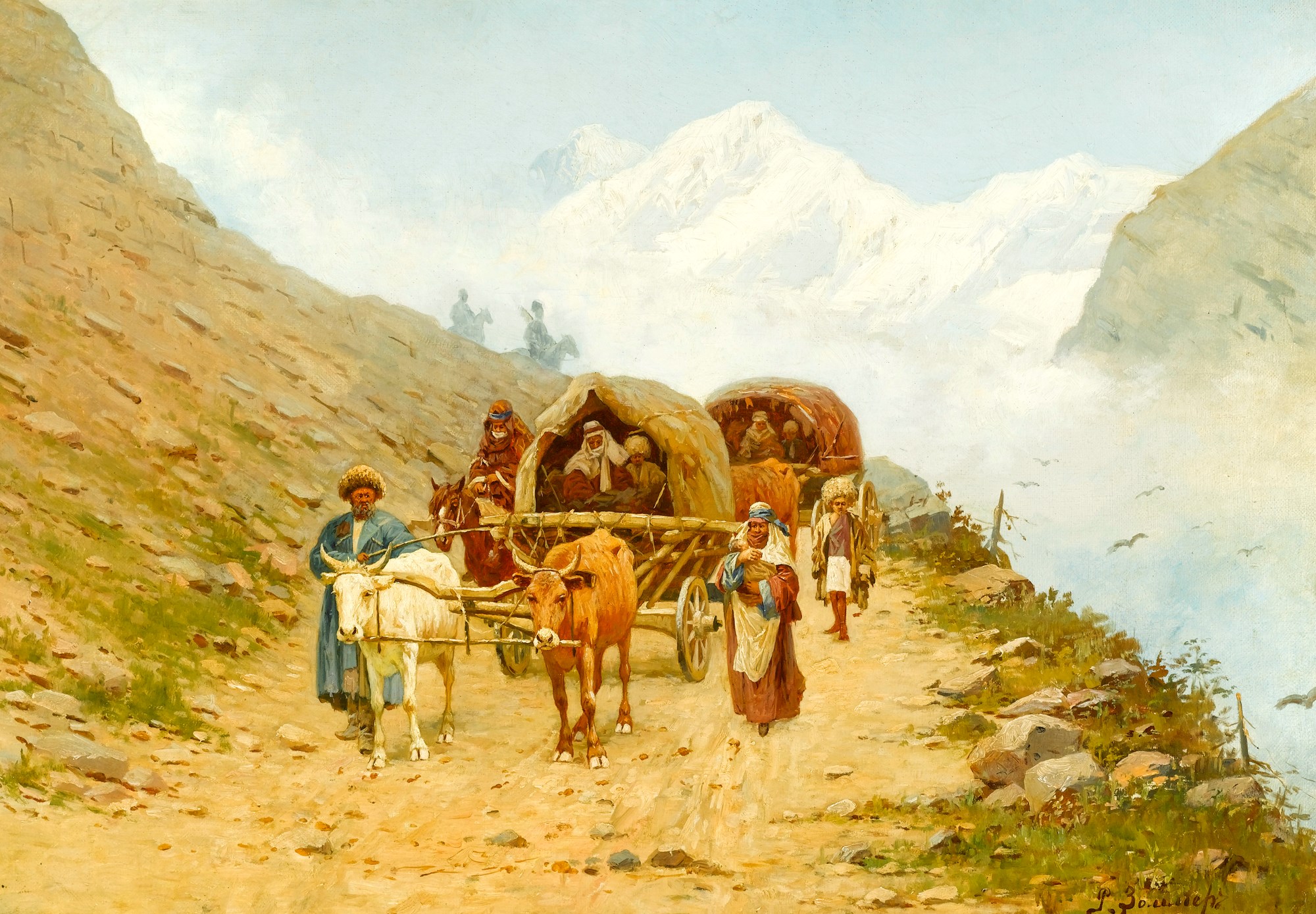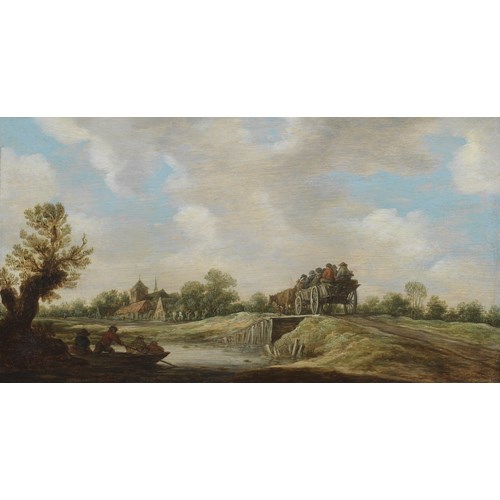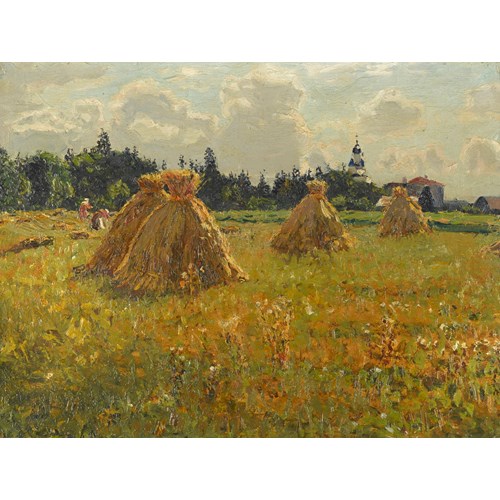Marketplace
Caucasian Caravan
Richard Karlovich Zommer
Caucasian Caravan
Period 1850-1900, 19th century, 20th century
Origin Germany, Russia
Medium Oil on canvas
Dimension 47 x 68 cm (18¹/₂ x 26³/₄ inches)
Against the backdrop of the snow covered Caucasian Mountains, a nomadic group travel in their wooden carts, pulled by oxen. A little boy, wearing a Karakul sheep papakhi, and a mother cradling her baby from the cold, walk alongside the main group. At first glance, they appear to be representative of the pastoral nomadic tribes of the Caucasus. Mass migration of hundreds of thousands of people across the plains of western and central Asia was once the norm. Moving their families, cattle, and horses, the pastoral nomads would migrate twice yearly seeking fresh pastures for their livestock to feed from, moving to more fertile, higher land with the thawing of the first snow in early spring, and lower down in the autumn, ahead of the freezing winter. However, closer examination of the male figure on the left hand side of the painting may reveal a more disturbing interpretation of the painting.
The figure appears to be wearing a traditional caftan-like coat of the people of the Caucasus. With its deep ‘V’, and breast cartridge pockets, it is typically associated with the Circassians. The identification of the coat, coupled with the solemn expressions of the figures, their exhausted cattle, and the two ominous figures on horseback in the background of the work seem to suggest that Richard Karlovich Zommer is in fact retelling the plight of the Circassian people.
Spanning from the 1770s to 1864 the Circassians had fought on and off battles against the Russians. They were slowly conquered and overcome by the Russian Army in a series of campaigns, and after the Crimean War, Russia turned her attention to the Caucasus in full. Several indigenous groups from the northwest Caucasus were exiled and deported to the Ottoman Empire, whilst a minority were resettled in other parts of Russia. This policy was enforced by mobile columns of Russian riflemen and Cossack cavalry, the two armed figures on horseback depicted in the background of Zommer’s work quite possibly being part of that cavalry.
The exodus continued into the 1870s. The hundreds of thousands were predominately Circassians but also included Ubykhs, Abkhaz, and Abaza. The Russians had come to refer to them collectively as gortsy, meaning mountain dwellers. The army rounded them up, and moved them from their villages to ports on the Black Sea, where they were transported to the Ottoman Empire. Leo Tolstoy gave the following account: ‘It had been the custom to rush the auls (mountain villages) by night, when, taken by surprise, the women and children had no time to escape, and the horrors that ensued under the cover of darkness when the Russian soldiers made their way by twos and threes into the houses were such as no official narrator dared describe’.1
An unknown number perished, dying from epidemics spread among the crowds at the ports of departure and arrival. Others perished at sea, when ships sank during treacherous weather.
1Baddeley, J.F., The Russian conquest of the Caucasus, 1908, p.446.
The figure appears to be wearing a traditional caftan-like coat of the people of the Caucasus. With its deep ‘V’, and breast cartridge pockets, it is typically associated with the Circassians. The identification of the coat, coupled with the solemn expressions of the figures, their exhausted cattle, and the two ominous figures on horseback in the background of the work seem to suggest that Richard Karlovich Zommer is in fact retelling the plight of the Circassian people.
Spanning from the 1770s to 1864 the Circassians had fought on and off battles against the Russians. They were slowly conquered and overcome by the Russian Army in a series of campaigns, and after the Crimean War, Russia turned her attention to the Caucasus in full. Several indigenous groups from the northwest Caucasus were exiled and deported to the Ottoman Empire, whilst a minority were resettled in other parts of Russia. This policy was enforced by mobile columns of Russian riflemen and Cossack cavalry, the two armed figures on horseback depicted in the background of Zommer’s work quite possibly being part of that cavalry.
The exodus continued into the 1870s. The hundreds of thousands were predominately Circassians but also included Ubykhs, Abkhaz, and Abaza. The Russians had come to refer to them collectively as gortsy, meaning mountain dwellers. The army rounded them up, and moved them from their villages to ports on the Black Sea, where they were transported to the Ottoman Empire. Leo Tolstoy gave the following account: ‘It had been the custom to rush the auls (mountain villages) by night, when, taken by surprise, the women and children had no time to escape, and the horrors that ensued under the cover of darkness when the Russian soldiers made their way by twos and threes into the houses were such as no official narrator dared describe’.1
An unknown number perished, dying from epidemics spread among the crowds at the ports of departure and arrival. Others perished at sea, when ships sank during treacherous weather.
1Baddeley, J.F., The Russian conquest of the Caucasus, 1908, p.446.
Period: 1850-1900, 19th century, 20th century
Origin: Germany, Russia
Medium: Oil on canvas
Signature: Signed in Cyrillic (lower right).
Dimension: 47 x 68 cm (18¹/₂ x 26³/₄ inches)
More artworks from the Gallery









 The Harvest_T638810975891048810.jpg?width=500&height=500&mode=pad&scale=both&qlt=90&format=jpg)